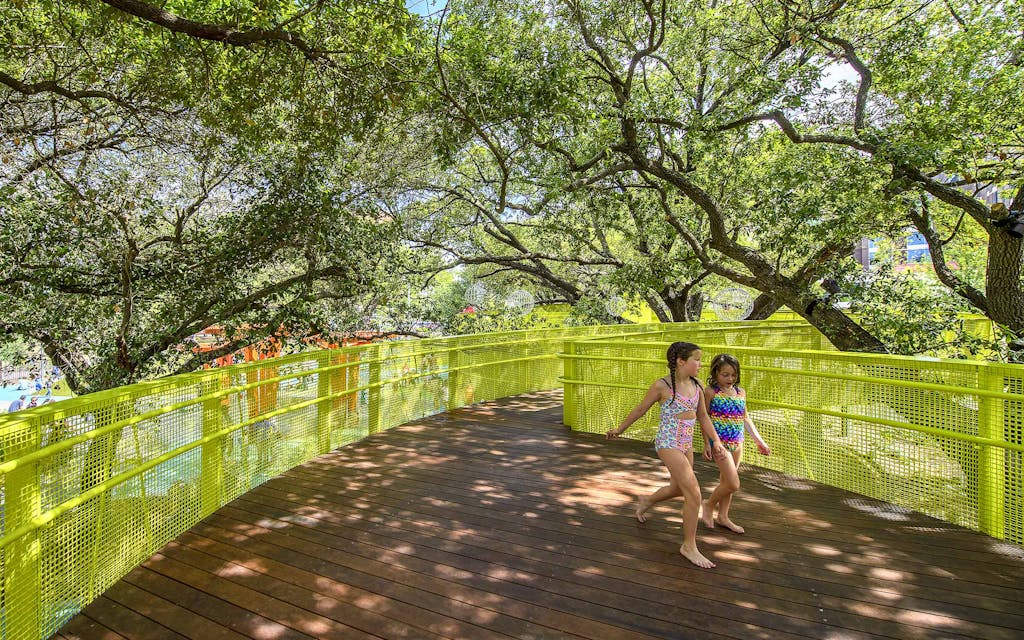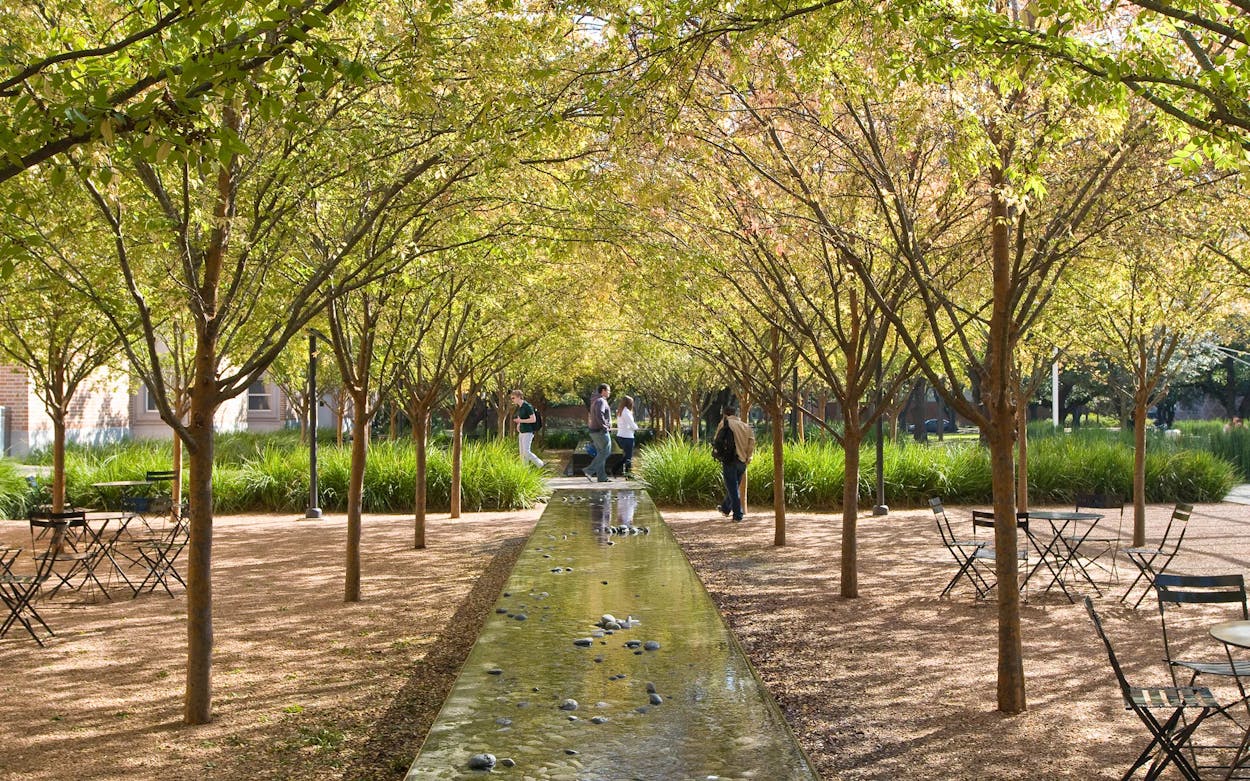“I think reconnecting, recharging with nature has been one of those things that have really helped us get through a lot of the stress and anxiety and challenges of the last year and a half,” says landscape architect Jim Burnett. Like many, he’s taken advantage of spending a little extra time at home to focus on growing fruits and vegetables: jalapeños, herbs, four kinds of tomatoes, and watermelon. The last of those, he admits, died on the vine, but for him gardening is more about the process than the end result: “Just looking at edible landscapes has been kind of fun . . . and I don’t have a really big garden.” But, of course, “really big” is subjective, and no backyard patch of salad ingredients could measure up to the Texpat’s other gardens. His eponymous firm, OJB (née Office of James Burnett), designed Dallas’s Klyde Warren Park, reimagined Houston’s Levy Park, and installed the serene surroundings at Rice University, all of which are featured prominently in OJB’s new book, Envisioning Landscapes, out this month from the Monacelli Press. For many of the projects, the book notes how the firm considers climate change in its designs—from choosing native plants to emphasizing shade.
Though Burnett only grew up in Dallas for part of his childhood (he was born in Biloxi, Mississippi, and later resided in Baton Rouge, Louisiana) and didn’t return to the Lone Star State until after college, “I still kind of think of myself as being from Texas,” he says. “My two boys were born there, and I met my wife in Houston and have a real soft spot for Texas.” After five years of working at an architecture firm in Houston, Burnett started his own practice there in 1989. In 2002, as work increasingly took him to the West Coast, he moved to San Diego to open another branch of his company. Today, he and his team still have an office in Houston, as well as ones in Dallas, Boston, and Philadelphia; the company specializes in creating serene, eco-friendly outdoor public spaces across the country. Community is at the heart of the firm’s design projects, which range from college campuses and hospitals to parks and gardens. Flipping through them in OJB’s soothing new book is a study in beautiful but functional design: friends enjoying picnics alongside botanical borders, strangers assembling for concerts in alfresco arenas, and families enjoying afternoons on shaded playgrounds.
Wherever and whatever the project, Burnett says OJB has the same simple objective: to design with both nature and the human body in mind. It’s a strategy Texans can adopt in our own backyards: think about how you’d like to use the space, and then decide what to plant, and where, in order to create a comfortable experience that is also good for the environment. The formula sounds foolproof. But as many of us learned in the aftermath of February’s freeze, as well as in the droughts that are becoming more frequent and severe, not all plants can survive our changing climate.

“We’re undergoing climate change at a rapid pace, and we’re seeing more extreme changes,” says Burnett. As a result, he says, the USDA is rewriting its plant hardiness zone maps, which indicate which plants will thrive in a given area: “Things that used to grow in far West Texas are now growing in areas of Texas that really get pretty cold and have a lot of rainfall.” What’s a gardener to do this planting season?
If you’re just getting started (or restarted, after losing plants to the freeze), don’t be deterred. Think of this as an opportunity to redesign your home life; to change the outdoor spaces around you—a key concept featured throughout the parks in OJB’s new book. “All of these projects were really strong transformations: they looked one way and now they look totally different, and they’re being used differently and supporting people in a different way,” Burnett says. “We want them to help the spirit, to help people become inspired. We want these gardens to be places where special things happen.”
Want to achieve the same effect in your own backyard? With Burnett’s guidance, here are six tips for how to build a sustainable garden that you’ll continue to enjoy year-round, come what may.
Think Like a Landscape Designer
“Science and technology tell us one thing—the metrics of what’s happening, which plants are going to die and survive, how much rain we’re going to have, and what floods and fires are going to do to us—but designers are the ones that take all this information and synthesize it,” Burnett says. “They come back and say, ‘This is the landscape that is going to support your needs: you can have breakfast here in the shade in the morning, you can start your day smelling the flowers, you can move in the afternoon when the sun is most intense, and these are where the breezes are coming.’”
So to kick off every project, Burnett says he and his partners at OJB ask simply, “Okay, what’s the program?” This should be the easy part. Stand outside your home and imagine how you’d like to enjoy it throughout the day, across all occasions.
Track Your Sunshine—and Work With It
Burnett says a general phrase to keep in mind is “design with climate”—and “the sun is the biggest part of the climate.” Watch it move across the sky and take note of where it rises and sets over your property, and at which times of day. Then you can manage it. “It might be with a pergola, a tree, an arbor, an umbrella,” he suggests.
If you decide to plant a tree (and this is about the time of year to do it), you’ll create natural shade—“which typically, in Texas, probably cools a microenvironment ten degrees,” Burnett says. His team achieved this at Levy Park by relocating live oaks into a vast canopy. Before you buy a specific type of tree, though, consider how much shade you need and how much coverage you’ll get from that variety. “It depends on how wide the leaf is, and if it’s dappled light or full shade.” For more of a rooflike canopy, Burnett suggests opting for magnolias and oaks. To let a little sun come through, consider a crepe myrtle, a honey locust, or some elms.
Add Water
Want to cool things down even more? Burnett says the sight and sound of water alone can trick you into feeling less stifled, like psychological air-conditioning. Visit your local garden center for ideas on how to incorporate a water element at home, such as a birdbath or a trickling waterfall.
You could say that trees and water are a winning combination to cool things down, too: in a desert garden the OJB team installed in California, for example, the soothing trickle of running water and the dappled shade of palo verde trees are a balm for visitors to the arid environment.
Understand Your Rainfall
After a downpour, watch where the rain goes. “It’s a big goal on most of our projects that we hold the water on-site,” Burnett says. “Most of the time we’re really working hard to take all that rainfall, either let it seep back into the groundwater or capture some of it, and then use that as our irrigation water to put back on our plants as it dries out.” This leads to more sustainable and affordable backyard gardening, too.
Some of Burnett’s larger projects employ cisterns and catchment areas to direct and retain rainfall. At home, you might opt for a rain barrel. Or you could create a bioswale, a planted area that makes use of stormwater runoff. “Purposefully design it to be a low area, and put in plants that can stand having their feet wet for a day or day and a half at a time when you have a rain,” Burnett says. “You would want to focus on iris and reeds, and things like horsetail.” Installing a simple rain gauge can also help you track precipitation and remember when it’s time to water.
Select Native Plants (With Ambience in Mind)
“I think that what we’re seeing is plant selections have to be made with the understanding that by the end of this century, we’re going to be five to seven degrees hotter in the summer,” Burnett says, adding that Texas will also likely be colder in the winter. As ever, this means opting for native species is your best bet: “A lot of these natives have been through centuries, and they’re still here. And some of these plants also have a real intelligence to them: they know when there’s a drought to conserve more water.”
In addition to being master survivalists, plants also help the environment. At Boston’s Mass General Brigham administrative campus alone, the native and adaptive species installed by Burnett’s team double as eco-friendly workhorses, sequestering “nearly forty thousand pounds of carbon annually,” according to Envisioning Landscapes. As an added bonus, the right combination of plantings can mitigate noise as well.
Plants should also, of course, create ambience. At Dallas’s Klyde Warren Park, where OJB outfitted different areas with varying flora, one tucked-away corner was planted with quiet moments in mind: “You can pick up a bistro chair and sit right next to some three- or four-foot plantings and feel like you’re in a backyard,” Burnett says.
Similarly, at home, “you can have little places in the garden that do different things”—both for you and for the environment. If you’re creating a lawn area, you might opt for buffalo grass “for something that’s not too much of a water-hog,” Burnett says. Want to grow some vegetables or a cutting garden of beautiful blooms? Lovely! But consider limiting the number of annual plants you install (at Rice University, for example, the team avoided annuals in order to achieve maximum sustainability). And then you could add a perennial wildflower garden to support the pollinators, like the butterfly garden OJB installed in the children’s play area of a downtown Oklahoma City park. As Burnett writes in the new book: “Even small gestures can make our environment better.”
Don’t Forget the Hardscape
Working on dreamy destinations like the Hall Wines facilities and gardens in Napa Valley, Burnett is also particularly attuned to the sensory experience of an outdoor space. At the vineyard, for example, it’s hard to deny that a glass of sauvignon blanc tastes better with a good view. And in true Hall family fashion (see the proprietors’ art-filled hotel in Dallas), Hall Winery’s meticulously appointed garden paths lead you to museum-quality installations throughout the property.
But what you may not notice are the materials within such paths themselves. “Crushed-granite gravel, which is really cool and gives a nice European quality, registers with your brain when you walk on it—even with shoes on,” Burnett says. In addition to the environmental benefits—as a permeable surface, the gravel allows water to seep through and recharge the groundwater—he says the paths have a texture that sends a signal that “you’re outside; you’re in a garden.” And just like that, you should feel calm and relaxed, perhaps a bit like Burnett does in his backyard veggie patch each day.
Get a Texan’s guide to the good life—in one weekly newsletter. It’s called Staying In With TM and is filled with tips and advice, story highlights, and great reads.
- More About:
- Style & Design
- Architecture
- Houston
- Dallas
- Austin








